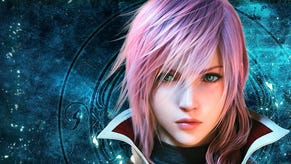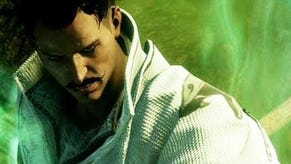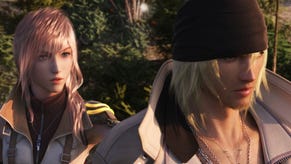Final Fantasy XIII
Unlucky for some.
It's late on the second day of E3 2009. A hot and bothered collection of half a dozen game journalists from the US and Europe is crammed awkwardly around one side of a table in an interview room at the back of the Square Enix booth, straining to hear against the muffled boom of the show floor. They're bristling with cameras, microphones and grumpy, it's-been-a-long-day attitude. It has. It's been a long week.
On the other side of the table sit an interpreter, Yoshinori Kitase and Motomu Toriyama. Kitase is the producer of Final Fantasy XIII and head of Square Enix's elite development team. He's also a quiet legend, director of no lesser games than Chrono Trigger and Final Fantasy VII in his day. Placid, sleepy-eyed and wearing a permanent, wry half-smile, he mostly defers to his slick younger colleague Toriyama, director of Final Fantasy X-2 and now this next full-blown instalment in the series.
Kitase's playing the humble mentor, but his presence immediately stamps FFXIII with a sense of history and authenticity its predecessor arguably lacked. Final Fantasy XII was a departure for the series, a brave game with an immensely long and difficult development. Like its original helmsman Yasumi Matsuno - who had to leave halfway through its creation due to "health concerns" - it was a brilliant, troubled renegade. FFXIII, Kitase doesn't say as he innocently studies his hands, will be no such thing. It will be classic, by-the-book Final Fantasy. Or will it?
Toriyama's toying with a PlayStation 3 controller, giving us a heart-breakingly brief glimpse of the game beyond the dark high-tech and cool tones of the walkway battles we've seen in the trailers and Japanese demo. Snow Villiers - the roguish brawler with the bandana, boots, raincoat and surfer hair who's one of the game's resistance heroes - is exploring a ruined temple, site of a disaster, located on Pulse. Pulse is the cursed surface of the world beneath the lofty flying city of Coccoon, and Toriyama says it will be "a very large and open area, a really large-scale area that will have the feel of a world map".
The ruined temple is utterly gorgeous. Gigantic sandstone pillars disappear into airy, sun-washed vaults, bright crystals stud the view, and there's a sense of warmth, space and expanse that's been completely missing from what we've seen of the game before. Villiers encounters enemies in the landscape - FFXIII may have a more traditional battle system than XII's faux-MMO automation, but random battles are gone for good, it seems. PSICOM Rangers and Marauders, agents of Coccoon's army, can only be described as Aztec ninja cyborgs, like something out of an alternate-universe Metal Gear Solid. Toriyama has Villiers battle some filigree butterfly monsters while he explains that, when performed aerially, attacks will have different effects than on the ground.

"Now we'd like to show you a summon," he says. "The summon system for this game actually has a Normal mode and a Gestalt mode. What happens when you first summon them, it goes into Normal mode, the summons actually replace your party members in battle and they support you there." We saw this at the Microsoft conference the day before, when poster girl Lightning was shown summoning the giant Odin and deploying him in battle in the standard, menu-based manner.
"Up till now everything was a command-based battle system, but once we go into the Gestalt mode which we'll show you right here, the battles become action-based," says Toriyama casually. In a customarily dramatic animation, Villiers summons twin sisters goddesses Shiva, who dance together in the air before locking limbs, combining and falling to earth as... well... an ornate, art-nouveau science-fiction motorbike.
"Shiva turns into a bike in her Gestalt mode, so you get the sense of controlling the bike directly to attack your enemies." Villiers mounts his improbable steed, and the menu system is replaced by a gauge and what look like button prompts for attack combos. Toriyama smashes through the remaining enemies in a fashion that looks like a showy hybrid of Devil May Cry and RPG on wheels. "And that's all for the demo."
As E3 reveals go, it's very slight - but still significant. Square has been stressing that it wants FFXIII's battle system to be more pacey and dynamic for some time, and that's been evident in the punchy, acrobatic moves, and the new Active Time Battle system with its queue-up action slots and recharging health. Still, direct control, even if it's just for the occasional summon, is a major breach in the age-old walls of Japanese RPG tradition. Maybe Final Fantasy XIII isn't so conservative after all.










.png?width=291&height=164&fit=crop&quality=80&format=jpg&auto=webp)




.jpg?width=291&height=164&fit=crop&quality=80&format=jpg&auto=webp)
